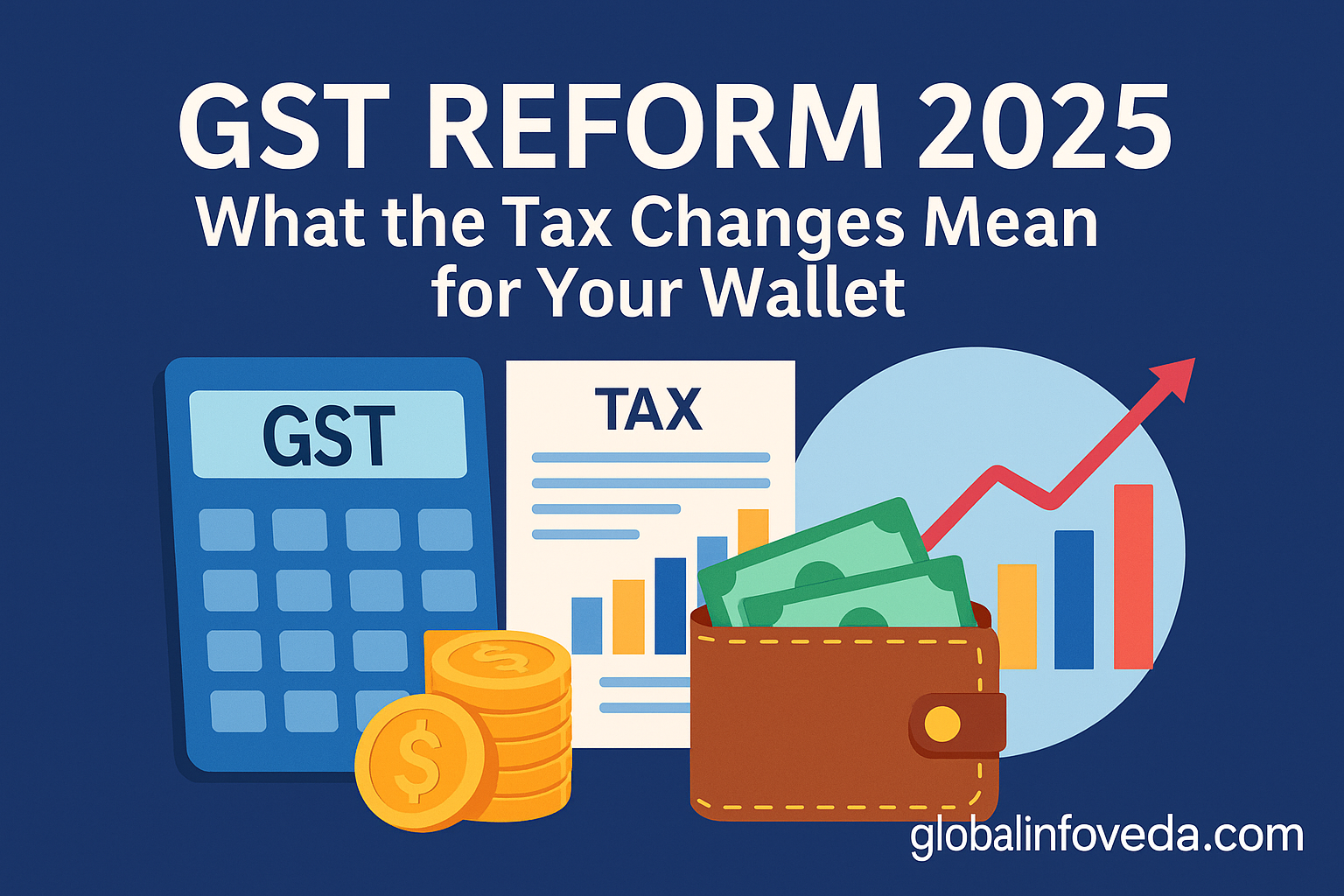GST Reform 2025
The Goods and Services Tax (GST) regime in India is undergoing its most significant transformation since its launch in 2017. The 2025 GST reform, approved by the GST Council and backed by the Finance Ministry, aims to simplify compliance, enhance transparency, and adjust tax rates to reflect current consumption patterns. It introduces a more intuitive tax structure, digitizes reporting systems further, and attempts to reduce leakage while supporting small businesses and enabling consumer savings.
But what do these changes mean for everyday Indians and their wallets? Whether you’re a salaried professional, freelancer, small business owner, or student, the 2025 GST reform will impact what you spend, save, and earn—and how you interact with the tax system daily.
🧾 Key Changes in GST 2025
1. Revamped Slabs: From Four to Three
- India’s original GST had four slabs: 5%, 12%, 18%, and 28%. These are now streamlined into: 8%, 15%, and 28%.
- 8% slab now covers most mass-consumed items: essential groceries, hygiene products, low-cost clothing.
- 15% slab absorbs former 12% and 18% categories: personal electronics, furniture, consumer services.
- 28% slab retained for luxury goods: high-end cars, tobacco, and aerated beverages.
- Zero-rated and exempt goods—like education, health, milk, and public transport—remain untouched.
2. Reclassification of Common Goods & Services
- Standardized slabs prevent overlap. For example:
- Packaged flour, paneer, ghee: reduced to 8%
- Branded garments, laptops, OTT subscriptions: unified under 15%
- Hotel rooms above ₹7,500, luxury watches, and private aviation: 28%
3. Input Tax Credit (ITC) Reform & Automation
- Full automation using AI-integrated GSTN dashboard.
- Real-time supplier invoice reconciliation reduces mismatch delays.
- Partial credit allowed on employee welfare expenses if mandated by law (healthcare, safety gear).
4. Boost for Online Sellers & MSMEs
- Threshold for compulsory registration under GST increased to ₹40 lakh (goods) and ₹25 lakh (services).
- E-commerce vendors now allowed aggregate filings across states using a single registration.
- GST Composition Scheme limit extended to ₹2 crore turnover.
5. Invoicing Technology Upgraded
- QR-based e-invoicing now mandatory for turnover above ₹5 crore.
- New “Scan & Verify” functionality built into MyGST consumer app—useful to detect fraud.
- Retailers incentivized via cashback to issue QR-linked invoices, promoting digital traceability.
💸 How This Affects Household Expenses
What Gets Cheaper:
- Branded and organic food products like pulses, rice, and packaged spices.
- LED bulbs, chargers, routers, and solar panels.
- Public transport app-based bookings like metro smartcards and bus e-tickets.
What Gets Slightly Costlier:
- Processed foods and packaged beverages, including frozen meals.
- Dining out in mid-segment restaurants, especially those with air-conditioning or centralized kitchens.
- Digital subscriptions (music, streaming platforms) due to 15% standardization.
What Stays the Same or Neutral:
- Rent, electricity, petrol, diesel, and liquor remain out of GST’s scope.
- Real estate under construction continues to be taxed at effective 5% without ITC.
🧠 Implications for Citizens
For Salaried Individuals:
- Services purchased for home offices or tax-eligible side hustles can now claim pro-rated ITC.
- Credit card, EMI purchases from GST-compliant retailers may qualify for invoice-linked cashback.
For Freelancers, Designers, Consultants:
- Mandatory GST registration if income crosses ₹20 lakh annually.
- ITC available on software tools, office co-working rent, and equipment.
- Simplified one-page return filing via new GSTR-Lite app.
For Small Traders & Kirana Stores:
- Composition dealers now allowed digital payments via UPI + GST QR codes.
- Government-led GST refund fast-lane for vendors in North-East and J&K under border region subsidies.
🧮 Digital Transformation in Tax Collection
- GSTN 2.0 now uses pattern-recognition for invoice tampering detection.
- E-way Bill + Fastag integration detects evasion in logistics and warehousing.
- Businesses with 80%+ real-time matching compliance qualify for lower audit frequency.
- AI chatbots embedded into GST filing portals help troubleshoot errors and guide small taxpayers.
📊 Industry & Expert Perspectives
- CII and FICCI called it “India’s boldest indirect tax modernization.”
- Startups and SaaS companies benefit from uniform 15% rate and improved credit flow.
- Tax think tanks caution on transition logistics—retraining accountants and updating ERP software.
🔮 What’s Coming Next
- Pilot for GST on fuel and aviation turbine fuel (ATF) may launch in late 2025.
- Review of GST applicability on cryptocurrency platforms and online influencers underway.
- Future roadmap includes GST Blockchain Ledger for high-value B2B traceability.
🧾 Final Word
The 2025 GST Reform isn’t just a tax rate reset—it’s a leap toward data-driven, people-first taxation. For consumers, the result is smarter pricing, more digitized receipts, and better awareness of what you’re being taxed for. For businesses, it’s a nudge toward formalization, digitization, and transparency.
For your wallet, it could mean better savings, smarter spending, and fewer compliance headaches.
Stay updated on financial reforms, tax policies, and savings strategies at GlobalInfoVeda.com
